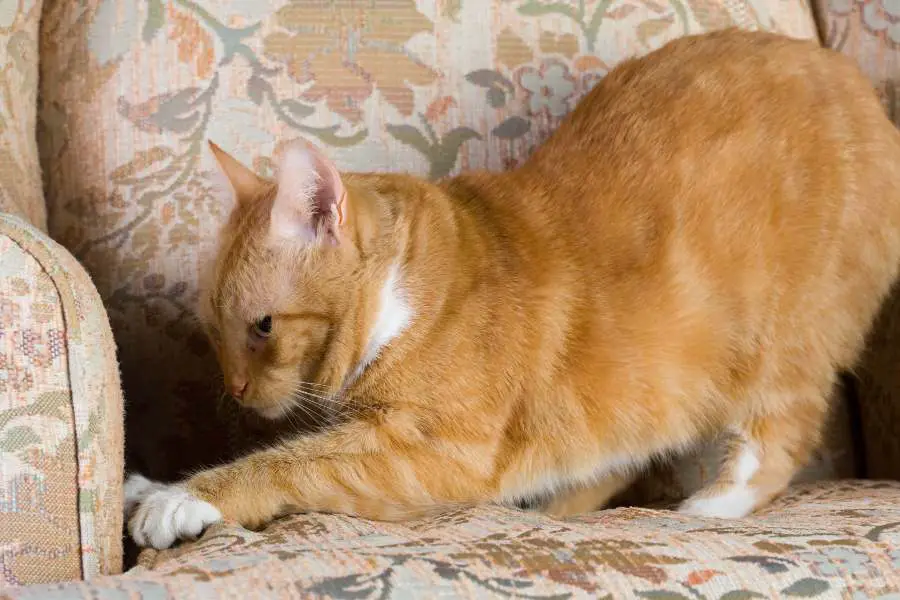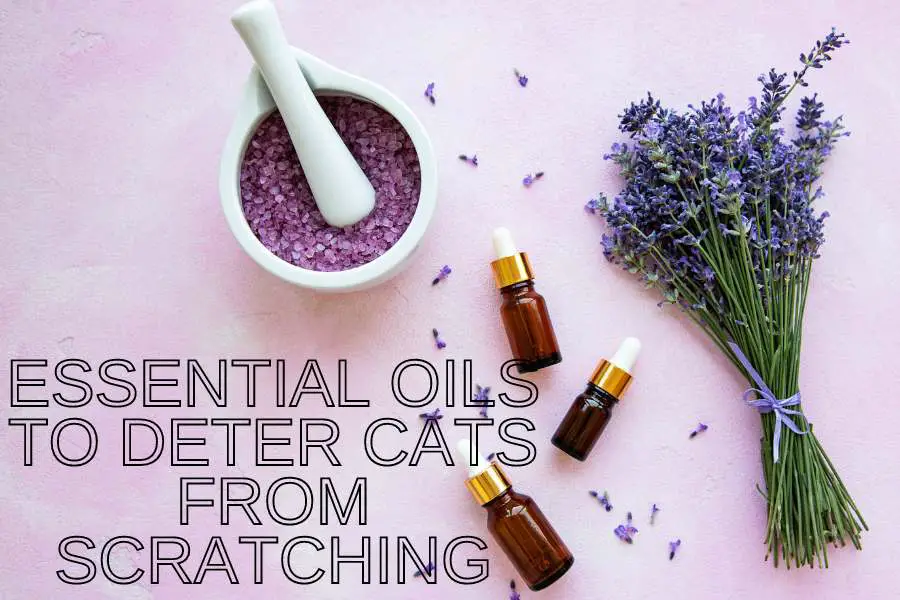Every cat owner knows, scratching is an innate behavior in cats, both at home and in the wild. Cats like to scratch before or after a nap or when playing. It helps the cat polish and maintain its claws, stretch its upper body, spread its scent, and have fun. But as much as we love our pet cats, we also love our décor. Let’s face it, clawed furniture is quite unsightly!
As such, we will show you how to use essential oils to deter cats from scratching your furniture, carpet, walls, or any other valuable in your home. In this article, we will also highlight the other methods you can combine with essential oil sprays to achieve even better outcomes regarding stopping your cat from scratching.
You Might Also Be Interested In Learning How To Stop Your Cat From Peeing In The House
Remember, the goal is not to entirely suppress your cat’s desire to scratch, which is nearly impossible to achieve and may lead to other unwanted behaviors. You have to provide an alternative scratching surface for the cat and place it near the places your cat likes to scratch.
We will revisit this point later and explain the significance of well-placed cat towers and horizontal and vertical scratching boards in deterring your cat from scratching your furniture at home.
What Are Essential Oils?

At their core, essential oils are concentrated oils produced from particular plant parts. They contain natural compounds extracted from the plants and have a distinctively strong scent.
For this reason, essential oils are used to make certain cosmetics, perfumes, fragrances, air fresheners, and flavorings. It is worth noting that essential oils have been widely used in alternative medicine and aromatherapy.
To humans, essential oils may have a sweet aroma (e.g., eucalyptus has a pleasant, woody, and minty smell), but the same odor could be unbearably horrible to cats. Also, lavender has a lovely, floral scent for humans, but the same smell is quite offensive to cats. Cats also loathe the citrus smell in citronella.
Pet owners can exploit the pungent odor in essential oils to stop their cats from scratching on furniture and other places in the house. Cats, by nature, have stronger senses of smell than humans and will be repulsed by essential oil spray repellents.
We will show you simple methods to prepare effective essential oil cat repellents at home using water, rosemary, eucalyptus, or citronella oil solutions, among other essential oils with smells that cats hate.
Is Using Essential Oils To Deter Cats From Scratching safe?
Before going any further, it’s essential we answer this questions: “Are essential oils safe for my cat?” In his book titled “How Conventional Veterinary Medicine May Be Harming Your Pets, and What You Can Do About It,” Dr. Andrew T. Jones insists essential oils are not poisonous to cats when applied topically, i.e., outside the cat’s body. They are only toxic when ingested by the cat or on the cat’s skin.
Therefore, you must avoid applying essential oils directly to your cat to prevent poisoning it. It is possible the cat could end up ingesting essential oil if it is licking its fur with droplets of essential oil when grooming. In addition, do not spray the essential oils on surfaces your cat licks.
“It is possible for cats to be poisoned by improper use of essential oil; however, it is a very rare occurrence in veterinary medicine.” Dr. Andrew T. Jones.
Why Essential Oils Can Be Toxic To The Cat

Essential oils contain phenols and other natural compounds that are impossible for a cat’s digestive system to break down. Being a pure carnivore, a cat’s liver lacks the enzymes or the P450 cytochrome metabolic pathway needed to digest and eliminate phenols and other compounds in essential oils.
Wondering what phenols are? They are a form of organic compound in the same group as alcohol but have a higher boiling point and are more difficult to digest.
For this reason, cats with underdeveloped livers or liver problems may be more susceptible to essential oil poisoning.
Learn how to make homemade anti-scratch spray with different ingredients.
What You Should Know When Using Essential Oils
Any essential oil diluted to 2% or lower is usually considered safe for the cat when applied away from the cat’s body.
To protect your cat from poisoning, you must avoid contact with your cat’s fur or skin when using essential oils. If you use a diffuser to spread the essential oil scent, you must avoid locking your cat in a room where the essential oils are being diffused.
Additionally, preferably use essential oil diffusers in rooms you’re absolutely sure you don’t want your cat to be in. Diffusing essential oil in a room your cat stays in will inadvertently lead to poisoning. For instance, diffusing essential oil in your living room, where your cat has its toys, bed, scratching post, food, etc., will affect your cat’s quality of life.
Owing to the essential oil odor, the cat will keep away from and will not have access to contents in the room. Alternatively, your cat might brave itself up, enter the room and suffer health consequences – some even life-threatening.
The following essential oils are less safe for cats when ingested or applied to the skin because of their high concentration of phenols or salicylates:
- Clove oil
- California ivy
- Ylang ylang
- Geranium
- Sweet Birch (Betula Lenta)
- Wintergreen
- Pennyroyal oil
If you suspect your cat has accidentally ingested essential oils, it may exhibit the following symptoms:
- Drooling
- Ataxia
- Vomiting
- Breathing difficulties
- Low temperature and heart rate
- Liver failure
Note: According to vets, the above symptoms can only be caused by the improper use of essential oils. When used appropriately, essential oils effectively deter a cat from scratching on specific surfaces in your home.
Now that we have discussed how not to use essential oils, the following section will show you the essential oils you can use to alter your cat’s behavior, simple essential oil cat repellent recipes, and how to use the repellent to stop your cat from ruining your furniture.
Simple Essential Oil Cat Repellent Recipes
We recommend using the following essential oils when preparing your essential oil cat repellent at home:
- Rosemary essential oil (clinically proven to be safe for cats)
- Lavender essential oil (has anti-anxiety properties and may assist your cat in remaining calm).
- Lemon essential oil
- Eucalyptus essential oil
- Citronella essential oil
- Peppermint essential oil
- Lemongrass essential oil
- Wild orange essential oil
- Cedarwood essnetial oil
- Mustard oil
How To Prepare An Effective Essential Oil Cat Repellent At Home

In reality, only some essential oil solutions work on some cats, and what may smell awful to one cat might not work with another. Because of that, you might have to try different essential oils to find the one that works for your cat. In addition, it is okay to be adventurous and consider mixing two or three different essential oils when looking for a more effective cat-repellent spray.
The section below shows some ways of preparing essential oil solutions and how to use them to deter your cat from scratching on certain surfaces at home.
1. Using Essential Oil And Water
Requirements:
- A glass spray bottle (because essential oils lose effectiveness quickly in plastic bottles).
- Rosemary essential oil (or any other option of your choice)
- Water (you may use tap, filtered, purified, or bottled water)
Procedure:
Step 1: Using a dropper, place 20 drops of your preferred essential oil in the glass spray bottle.
Step 2: Fill up the rest of the bottle with water.
Step 3: Close the bottle and shake it gently for the solution to mix properly. At this point, your essential oil cat repellent is ready for use. Test the solution in a low-traffic area of the house to avoid staining your valuable fabric.
Step 4: Spray on areas you want to keep your cat away from and reapply twice a day until you notice a change in behavior in your cat.
2. Using Essential Oil, Dish Liquid Soap, And Water
Requirements:
- A glass spray bottle
- Rosemary essential oil (or any other option of your choice)
- Clear dish soap (or lemon-scented, provided it does not stain your fabric) (Dish soap acts as a mixing agent, helping the oil and water to mix.)
- Water (you may use tap, filtered, purified, or bottled water)
Procedure:
Step 1: Using a dropper, place 20 drops of your preferred essential oil in the glass spray bottle.
Step 2: Fill up the rest of the bottle with water.
Step 3: Add one squirt of clear dish soap, close the bottle, and shake it gently for the solution to mix properly. At this point, your cat repellent is ready.
Step 4: Test the solution in a low-traffic area before you spray it on the places you want to stop your cat from scratching.
3: Essential Oil Solutions, Glycerine, And Distilled Water
Requirements:
- A glass spray bottle
- Lemon essential oil
- Rosemary essential oil
- Glycerine
- Distilled water
Procedure:
Step 1: Using a dropper, add 20 drops of rosemary essential oil and 20 drops of lemon essential oil in a spray bottle.
Step 2: Fill up the rest of the bottle with distilled water.
Step 3: Add one tablespoon of glycerine, close the bottle, and shake it gently for the solution to mix properly. At this point, your cat repellent is ready.
Step 4: Test the solution on low-traffic or inconspicuous areas of the carpet, and apply the cat repellent where you do not want your cat to scratch.
How To Keep Cats Off Furniture Using Essential Oils
As mentioned earlier, you may need to try different essential oil recipes to find one that is effective for your cat. In addition, you need to apply it once or twice a day while observing your cat to determine if the solution is working. Other than mixing the essential oils in a spray bottle, you may consider the following ways:
1. Using A Diffuser
You may opt to use a diffuser like an ultrasonic or a nebulizing diffuser. You will need to put the essential oil solution in the diffuser and place it where you do not want your cat to scratch or visit. For example, mix ten drops of lavender essential oil with one cup of water and place the solution in the diffuser.
In addition to deterring the cat from scratching on your furniture or carpet, diffusing the lavender solution can make the cat less anxious and reduce your cat’s yowling at night. This is because lavender has certain anti-anxiety qualities that help keep your cat calm.
2. Use A Soaked Cloth To Deter The Cat
Instead of using a spray bottle, you can soak a piece of clothing in essential oil and place it where you want to deter the cat from scratching.
Other Ways To Discourage Your Cat From Scratching Your Décor

While essential oils are effective in deterring cats from scratching your furniture, there are other methods of deterrence that can complement your essential oil. Creating a wholesome solution that attacks from different angles is essential for long-term scratching deterrence.
1. Trim Your Cat’s Nails Regularly
To reduce the chances of your cat ruining your furniture, it helps to cut your cat’s nails regularly (every one to two weeks) using an appropriate cat nail trimming setup such as a Grooming Hammock Harness Cats. Whether you take your cat to the vet of you DIY trim the nails, it must be done diligently to yield the desired results without harming your furry friend.
Consider buying a high-quality, affordable nail trimmer to groom your cat’s nails). The best trimmer has curved edges to apply pressure evenly around the whole nail, making the exercise comfortable for your cat (remember your cat has round claws).
2. Buying Soft Nail Caps For Your Cat
Soft nail caps are glued on the cat’s claws to stop them from scratching surfaces at home, thus safeguarding your couch from damage. The nail caps are safe for your cat as they’re manufactured using non-toxic materials. Importantly, the nail caps allow your cat’s claws to extend and retract freely.
They typically last four to six years before needing to be replaced. However, the caps’ durability depends on how you apply them. They must be applied correctly to function as they should. You may request that your vet assist you in applying the soft nail caps on your next visit.
3. Scratching Post (Vertical Scracthing Post or Horizontal Scratching Post)

As mentioned earlier, it is crucial to provide your cat with an alternative surface where it can meet its natural urge to scratch. This way, you can help redirect the cat away from your furniture, carpet, or fabric to where they should scratch.
To invite the cat to use the scratching post, use your fingers to make scratching gestures on the scratching post. Cats are indeed animal copyists and will start to do the same, trying to mimic you. Observational learning teaches them to start scratching the posts or boards instead of your furniture.
You could use catnip to attract the cat to the scratching post or board. Cats are drawn to catnip and cannot resist it. Or use honeysuckle spray to attract the cat to the scratching post if your cat does not like catnip.
Here are some considerations to keep in mind while looking for a scratching post:
The Number And Location Of The Scratching Post
The cat is rarely confined to one room in the house; cats love to move around the house and explore as part of their natural hunting instincts. For this reason, consider providing multiple scratching posts or boards and placing them strategically.
Moreover, place the scratching posts near the areas you do not want your cat to scratch. We recommend placing the scratching posts immediately in front of the couch, carpet, or furniture you want to safeguard from claw damage.
It is also not uncommon for some cats to want to scratch after their bathroom break to remove litter from their claws; you might want to place a scratching post near the litter box.
The Design Of The Scratching Post
You need to determine if your cat likes to scratch vertically or horizontally, as this should inform the type of scratching post or board you buy for your cat.
For example, horizontal scratchers are ideal for cats that scratch your carpet. Wedge-shaped ramps are suitable for cats that like scratching the lower ends of the furniture. Upright scratching posts suit cats that like to stretch when scratching. If you are still deciding what to choose, consider trying different posts or boards to find the one your cat likes most, as not all cats are the same.
The scratching Post Must Be Sturdy
The scratching post must be sturdy to prevent it from falling or collapsing on your cat when they are using it. If the base falls, the cat will not want to scratch it again and revert to scratching the more stable surfaces, like the couch.
Type Of Material
Generally, they prefer scratching on surfaces they can move their claws through, such as carpet, sisal fiber, or cardboard. A sisal wound and a stable post are both viable options.
According to cat-pet guru Jackson Galaxy, cats love scratching on natural wood as it closely resembles a tree—a natural scratching surface. Some cats like to scratch on redwood surfaces, while other cats prefer cedar planks.
4. Using Amazing Shield To Safeguard You Couch

Amazing Shield is a famous cat deterrent solution that safeguards your couch or other furniture from scratch damage. It is simple to use an amazing shield. You are only required to peel off the self-adhesive sticker or sheet and stick it on the area you want to safeguard from your cat’s claws.
Amazing Shields are suitable for use on leather or fabric, and they will not damage your couch or furniture when you finally peel them off. Also, when you remove them, they do not leave any residue on your sofa or home surfaces.
Every package of the Amazing Shield comes with six shields, each with a width of 12 inches and a length of 17 inches. However, you can cut the amazing shield into smaller pieces if you need to cover a small area from your cat’s scratching habit. They are clear, making them difficult to notice. Later on, you can remove them once your cat has stopped scratching.
5. Double-sided Tape Or Sticky Paws
Cats hate the sticky feeling of double-sided tape. They will tend to avoid scratching sticky surfaces. Consider buying sticky paws to discourage your cat from scratching your furniture or house walls.
6. Using A Vinyl Carpet Runner
Also, if it is workable, you can spread a vinyl carpet runner around your couch or furniture with the prickly underside of the carpet runner looking up. Your cat will automatically dislike walking in the area again, discouraging them from scratching the undesirable places.
7. Buy Your Cat A Cat Tree or Cat Tower
Cats like sleeping on elevated places; they love to climb on high levels, scratch on surfaces, and find the perfect spot to lodge for some time. Naturally, cats like to survey their environment as a core hunting instinct, and being on higher ground helps.
They enjoy jumping into small spaces and hiding and sitting inside hidey holes for hours. As you can appreciate, a cat tower with plenty of ramps to jump, hidey holes for hiding, and a good scratching surface will help divert their attention from the couch.
Consider buying a multi-level cat tree with good cubbies or hidey holes and scratching surfaces. Once you have bought a good cat tower or tree, be sure to place it near the window—somewhere the cat can see the external surroundings and stare at birds playing or insects flying around.
It is an excellent way to distress your cat and provide an alternative scratching and playing area.
8. Positive Reinforcement And Redirecting Behavior
Seek opportunities to reward the cat whenever it does something appropriate, like scratching on the scratcher board instead of your furniture. This is a great way to encourage your cat to adopt the proper behavior.
Also, you can place a few treats in different places near the scratching board or on the cat tree to attract the cat to spend more time there. This trick helps the cat develop a positive association with the scratching post, board, or cat tower.
Avoid yelling and punishing your cat simply because it is not helpful. On the contrary, negative reinforcement is likely to cause the development of far worse habits caused by anxiety disorders.
When you find the cat on the couch or in other unwanted places, gently pick it up and place it where it belongs; soon, the cat will learn. Here, timing is critical when interrupting and redirecting the cat’s behavior. You have to be patient with the cat, especially if you are dealing with a kitten – kittens tend to forget more often than not.
Conclusion
Sometimes, we look for complex solutions when the answer is simple—maybe your cat is acting out in search of your attention. Have you tried bonding with your cat? Can you make it a habit to spend time with your cat, playing with boxes, feathers, tunnels, etc.? You will be helping the cat exercise while bonding with your furry feline friend.
Whatever you do, please do not declaw your cat. It is a terrible and cruel thought. Declawing is the amputation of both claws at the last knuckle (about 1/3 of the cat’s paws) for both of your nails. It is painful and might cause your cat physical and mental anguish later.

